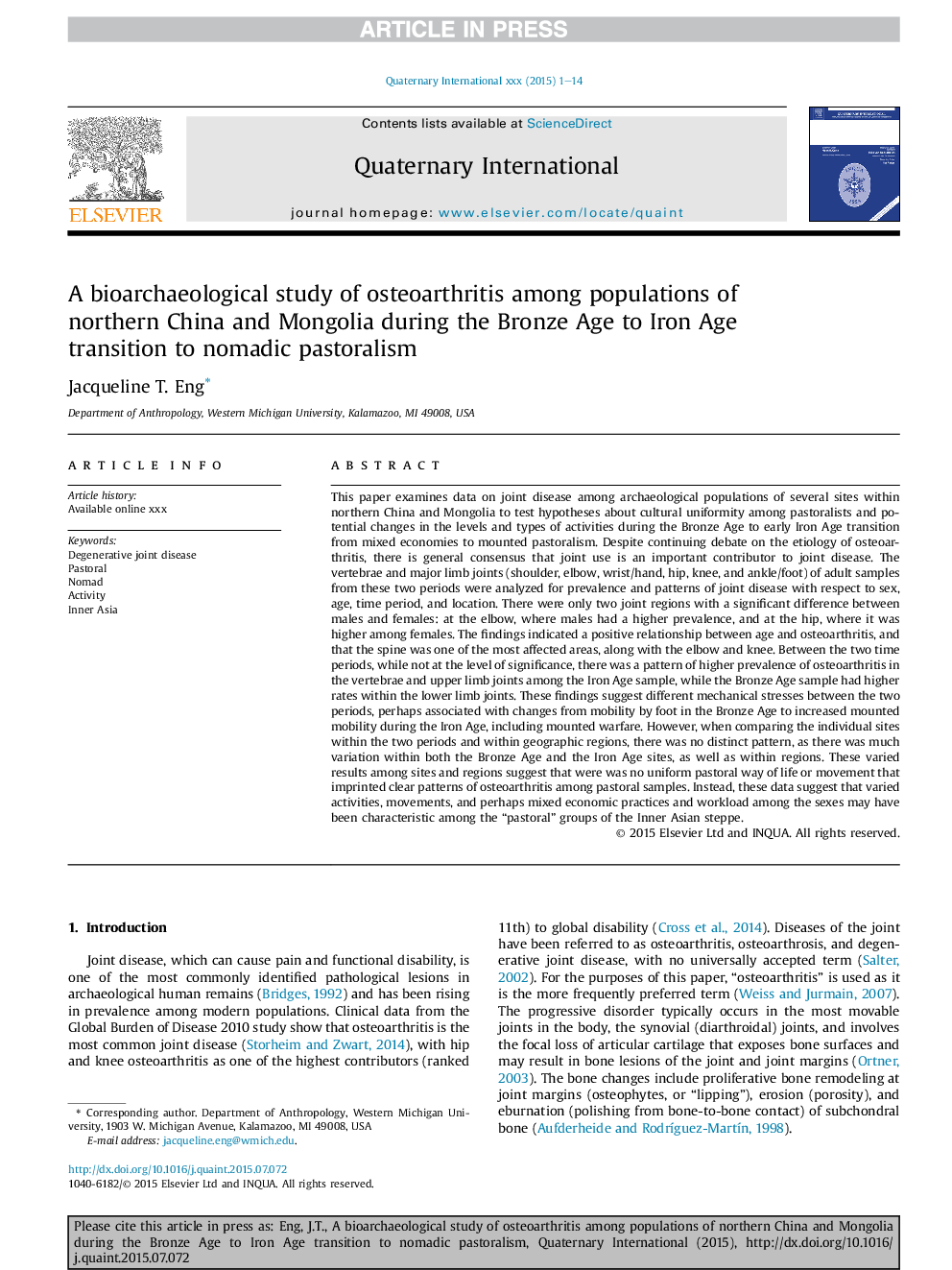| کد مقاله | کد نشریه | سال انتشار | مقاله انگلیسی | نسخه تمام متن |
|---|---|---|---|---|
| 10500892 | 944454 | 2016 | 14 صفحه PDF | دانلود رایگان |
عنوان انگلیسی مقاله ISI
A bioarchaeological study of osteoarthritis among populations of northern China and Mongolia during the Bronze Age to Iron Age transition to nomadic pastoralism
ترجمه فارسی عنوان
یک مطالعه زیست شناسی شناختی از استئوآرتریت در میان جمعیت های شمالی چین و مغولستان در دوران برنز تا گذر از زمان آهن به گاو عشایری عشایر
دانلود مقاله + سفارش ترجمه
دانلود مقاله ISI انگلیسی
رایگان برای ایرانیان
کلمات کلیدی
بیماری مفصلی تخریب شده معنوی، اسم فعالیت، آسیای داخلی،
ترجمه چکیده
در این مقاله، داده های مربوط به بیماری مفصلی در میان جمعیت های باستان شناسی چندین سایت در شمال چین و مغولستان مورد بررسی قرار می گیرد تا به آزمون فرضیه ها در مورد یکنواختی فرهنگی در میان گاو نر و تغییرات بالقوه در سطوح و انواع فعالیت ها در طول دوره برنز تا انتقال زود هنگام آهنین از اقتصاد مخلوط به نصب گاوداری علیرغم بحث مداوم در مورد علت پوکی استخوان، توافق عمومی وجود دارد که استفاده مشترک از اهمیت زیادی برخوردار است. نمونه های بالغ از این دو دوره، مهره ها و مفصل های اندام اصلی (شانه، آرنج، مچ دست / دست، لگن، زانو و مچ پا / پا) نمونه های بالغ از این دو دوره برای شیوع و الگوهای بیماری مفصل با توجه به جنس، سن، و محل تنها دو منطقه مشترک وجود داشت که اختلاف معنی داری بین مردان و زنان وجود داشت: در آرنج، که در آن مردان دارای شیوع بالایی بودند، و در ران، جایی که در میان زنان بالاتر بود. یافته ها نشان دادند که رابطه مثبت بین سن و استئوآرتریت وجود دارد و ستون فقرات در منطقه ای به نام زانو و آرنج بوده است. بین دو دوره زمانی، در حالی که در سطح معنی دار نبود، یک الگو از شیوع بیشتر استئوآرتریت در مهره ها و اتصالات اندام فوقانی در نمونه عصر آهن یافت شد، در حالی که نمونه عصر برنز در مفاصل اندام تحتانی بالاتر بود. این یافته ها نشان می دهد تنش های مکانیکی مختلف بین دو دوره، شاید با تغییرات حرکت از طریق پا در عصر برنز و افزایش تحرک جابجایی در عصر آهن، از جمله جنگ سوار شده همراه باشد. با این حال، هنگام مقایسه سایتهای فردی در دو دوره و در مناطق جغرافیایی، الگوی متمایزی وجود نداشت، زیرا تغییرات زیادی در هر دو عصر برنز و سنین آهنین و همچنین در مناطق وجود داشت. این نتایج متنوع در میان سایت ها و مناطق نشان می دهد که هیچ شیوه ای از زندگی انسانی و جنبشی وجود نداشت که الگوهای مشخصی از استئوآرتریت را در میان نمونه های خوابیده وارد کرد. در عوض، این داده ها نشان می دهد که فعالیت های متنوع، حرکات و شاید شیوه های اقتصادی متداول و حجم کاری در بین جنس ها ممکن است در میان یک پاپورالا مشخص باشد؟ گروه های استپ داخلی آسیایی.
موضوعات مرتبط
مهندسی و علوم پایه
علوم زمین و سیارات
زمین شناسی
چکیده انگلیسی
This paper examines data on joint disease among archaeological populations of several sites within northern China and Mongolia to test hypotheses about cultural uniformity among pastoralists and potential changes in the levels and types of activities during the Bronze Age to early Iron Age transition from mixed economies to mounted pastoralism. Despite continuing debate on the etiology of osteoarthritis, there is general consensus that joint use is an important contributor to joint disease. The vertebrae and major limb joints (shoulder, elbow, wrist/hand, hip, knee, and ankle/foot) of adult samples from these two periods were analyzed for prevalence and patterns of joint disease with respect to sex, age, time period, and location. There were only two joint regions with a significant difference between males and females: at the elbow, where males had a higher prevalence, and at the hip, where it was higher among females. The findings indicated a positive relationship between age and osteoarthritis, and that the spine was one of the most affected areas, along with the elbow and knee. Between the two time periods, while not at the level of significance, there was a pattern of higher prevalence of osteoarthritis in the vertebrae and upper limb joints among the Iron Age sample, while the Bronze Age sample had higher rates within the lower limb joints. These findings suggest different mechanical stresses between the two periods, perhaps associated with changes from mobility by foot in the Bronze Age to increased mounted mobility during the Iron Age, including mounted warfare. However, when comparing the individual sites within the two periods and within geographic regions, there was no distinct pattern, as there was much variation within both the Bronze Age and the Iron Age sites, as well as within regions. These varied results among sites and regions suggest that were was no uniform pastoral way of life or movement that imprinted clear patterns of osteoarthritis among pastoral samples. Instead, these data suggest that varied activities, movements, and perhaps mixed economic practices and workload among the sexes may have been characteristic among the “pastoral” groups of the Inner Asian steppe.
ناشر
Database: Elsevier - ScienceDirect (ساینس دایرکت)
Journal: Quaternary International - Volume 405, Part B, 16 June 2016, Pages 172-185
Journal: Quaternary International - Volume 405, Part B, 16 June 2016, Pages 172-185
نویسندگان
Jacqueline T. Eng,
